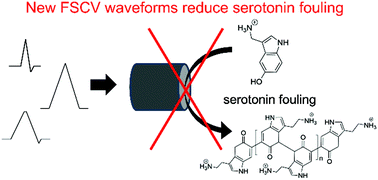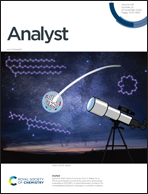Improving serotonin fast-scan cyclic voltammetry detection: new waveforms to reduce electrode fouling†
Abstract
Serotonin is a neuromodulator implicated in depression that is often measured in real-time by fast-scan cyclic voltammetry (FSCV). A specialized “Jackson” waveform (JW, 0.2, 1.0 V, −0.1 V, 0.2 V, 1000 V s−1) was developed to reduce serotonin fouling, but the 1.0 V switching potential limits sensitivity and electrodes still foul. The goal of this study was to test the effects of extending the FSCV switching potential to increase serotonin sensitivity and decrease fouling. We compared the Jackson waveform, the dopamine waveform (DA, −0.4 V, 1.3 V, 400 V s−1), and two new waveforms: the extended serotonin waveform (ESW, 0.2, 1.3, −0.1, 0.2, 1000 V s−1) and extended hold serotonin waveform (EHSW, 0.2, 1.3 (hold 1 ms), −0.1, 0.2, 400 V s−1). The EHSW was the most sensitive (LOD = 0.6 nM), and the JW the least sensitive (LOD = 2.4 nM). With the Jackson waveform, electrode fouling was significant with repeated injections of serotonin or exposure to its metabolite, 5-hydroxyindoleacetic acid (5-HIAA). Using the extended waveforms, electrodes fouled 50% less than with the Jackson waveform for both analytes. No electrode fouling was observed with the dopamine waveform because of the negative holding potential. The Jackson waveform was the most selective for serotonin over dopamine (800×), and the ESW was also highly selective. All waveforms were useful for measuring serotonin with optogenetic stimulation in Drosophila larvae. These results provide new FSCV waveforms to measure dynamic serotonin changes with different experimental requirements, like high sensitivity (EHSW), high selectivity (ESW, JW), or eliminating electrode fouling (DA).



 Please wait while we load your content...
Please wait while we load your content...